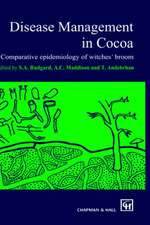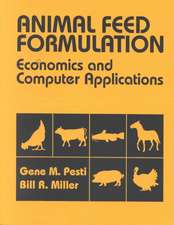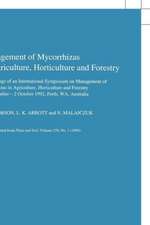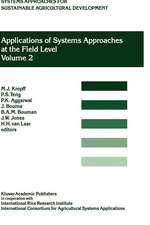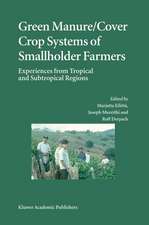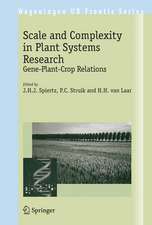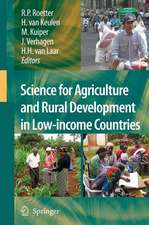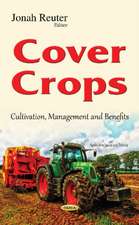Modelling Potential Crop Growth Processes: Textbook with Exercises: Current Issues in Production Ecology, cartea 2
Autor J. Goudriaan, H. H. Van Laaren Limba Engleză Hardback – 31 oct 1994
| Toate formatele și edițiile | Preț | Express |
|---|---|---|
| Paperback (1) | 942.76 lei 6-8 săpt. | |
| SPRINGER NETHERLANDS – 31 oct 1994 | 942.76 lei 6-8 săpt. | |
| Hardback (1) | 948.61 lei 6-8 săpt. | |
| SPRINGER NETHERLANDS – 31 oct 1994 | 948.61 lei 6-8 săpt. |
Preț: 948.61 lei
Preț vechi: 1156.84 lei
-18% Nou
Puncte Express: 1423
Preț estimativ în valută:
181.51€ • 190.03$ • 150.19£
181.51€ • 190.03$ • 150.19£
Carte tipărită la comandă
Livrare economică 07-21 aprilie
Preluare comenzi: 021 569.72.76
Specificații
ISBN-13: 9780792332190
ISBN-10: 0792332199
Pagini: 239
Ilustrații: XII, 239 p.
Dimensiuni: 170 x 244 x 16 mm
Greutate: 0.54 kg
Ediția:1994
Editura: SPRINGER NETHERLANDS
Colecția Springer
Seria Current Issues in Production Ecology
Locul publicării:Dordrecht, Netherlands
ISBN-10: 0792332199
Pagini: 239
Ilustrații: XII, 239 p.
Dimensiuni: 170 x 244 x 16 mm
Greutate: 0.54 kg
Ediția:1994
Editura: SPRINGER NETHERLANDS
Colecția Springer
Seria Current Issues in Production Ecology
Locul publicării:Dordrecht, Netherlands
Public țintă
ResearchCuprins
1 Introduction.- 1.1 Levels of understanding of crop growth.- 1.2 Growth factors and production situations.- 1.3 CO2 assimilation as a basis.- 1.4 Some general modelling considerations.- 1.5 Outline of the book.- 2 The main seasonal growth pattern.- 2.1 Introduction.- 2.2 The growth phases.- 2.3 Exponential-linear growth: one equation.- 2.4 A special case: rm, cm,p1 and s are constant.- 2.5 Application for variable weather conditions.- 2.6 Generalization on approaching the senescence phase.- 2.7 A term for losses due to maintenance respiration.- 2.8 Additional exercises.- 2.9 Solutions to the exercises.- 2.10 Symbols and acronyms used in Chapter 2.- 3 Climatic factors.- 3.1 Importance of the diurnal course.- 3.2 The daily progress of the incident global radiation.- 3.3 Temperature.- 3.4 Humidity.- 3.5 Wind speed.- 3.6 Annual temperature course.- 3.7 Additional exercises.- 3.8 Solutions to the exercises.- 3.9 Symbols and acronyms used in Chapter 3.- 4 Assimilate flow and respiration.- 4.1 Introduction.- 4.2 Growth and respiration.- 4.3 Short-circuiting the assimilate pool on the long-term.- 4.4 Growth respiration and chemical composition.- 4.5 Maintenance respiration.- 4.6 Additional exercises.- 4.7 Solutions to the exercises.- 4.8 Symbols and acronyms used in Chapter 4.- 5 Development and growth.- 5.1 Introduction.- 5.2 Development stages.- 5.3 Development rate and environmental factors.- 5.4 Distribution of dry matter and development stage.- 5.5 Leaf area growth.- 5.6 Solutions to the exercises.- 5.7 Symbols and acronyms used in Chapter 5.- 6 Radiation in crops.- 6.1 Introduction.- 6.2 A model crop with black horizontal leaves.- 6.3 Black leaves that are not horizontal.- 6.4 Horizontal leaves that are not black.- 6.5 Scattering leaves, non-horizontal.- 6.6 Scattering by leaves and soil.- 6.7 Distribution of absorption of light over the leaf canopy.- 6.8 Clustering.- 6.9 Additional exercise.- 6.10 Solutions to the exercises.- 6.11 Symbols and acronyms used in Chapter 6.- 7 Leaf energy balance and transpiration.- 7.1 Introduction.- 7.2 Energy balance of a non-transpiring leaf.- 7.3 Thermal (‘long-wave’) radiation: 3 – 20 ?m.- 7.4 Evaporation from a wet surface.- 7.5 Leaf transpiration.- 7.6 Units of conductance: m s?1 or ?mol m?2 s?1.- 7.7 Notation with the coupling factor Omega.- 7.8 Additional exercises.- 7.9 Solutions to the exercises.- 7.10 Symbols and acronyms used in Chapter 7.- 8 Analysis of leaf CO2 assimilation.- 8.1 Introduction.- 8.2 The photosynthesis-light response curve.- 8.3 The light and dark processes in CO2 assimilation.- 8.4 Limitation by low CO2.- 8.5 Maximal photosynthetic capacity (at both high light and high CO2).- 8.6 Limitation by low light.- 8.7 The C3 cycle, photorespiration and the CO2 compensation point.- 8.8 Temperature.- 8.9 Additional exercises.- 8.10 Solutions to the exercises.- 8.11 Symbols and acronyms used in Chapter 8.- References.- Appendix 1 Richards and Gompertz functions.- A1.1 Richards function.- A1.2 Gompertz function.- Appendix 2 Gaussian integration in simulation modelling.- A2.1 Introduction.- A2.2 Canopy photosynthesis.- A2.3 Solution to the exercise.- Appendix 3 SUCROS1 — A crop growth model for potential production.- A3.1 Introduction.- A3.2 Initial conditions.- A3.3 Crop development (Chapter 5).- A3.6 Carbohydrate production (Chapter 4).- A3.7 Maintenance (Chapter 4).- A3.8 Dry matter partitioning (Chapter 5).- A3.9 Growth of plant organs and translocation (Chapts 4 and 5).- A3.10 Leaf and ear development (Chapter 5).- A3.11 Dry matter production.- A3.12 Weather data(Chapter 3).- A3.13 Carbon balance check (Chapter 4).- A3.14 Run control.- A3.15 Structure and listing of the model.- A3.16 Definition of the abbreviations used in SUCROS1.- Appendix 4 SUCROS1 — adapted for soil reflection.- Appendix 5 The FORTRAN Simulation Translator (FST), a simulation language.- A5.1 Introduction.- A5.2 The structure of the model.- A5.3 FST example program simulating logistic growth.- A5.4 Comment lines and FST statements.- A5.5 Rules for FST keywords, variable names and values.- A5.6 Definition of input values of the model (PARAMETER, INCON, CONSTANT, FUNCTION).- A5.7 Hierarchy of operations in expressions, and the use of FST functions and FORTRAN functions.- A5.8 FST keywords for output (TITLE, PRINT, OUTPUT).- A5.9 FST run control keywords (TRANSLATION_GENERAL, TRANSLATION_FSE, TIMER, FINISH).- A5.10 Weather data in FST programs (WEATHER).- A5.11 Rerun facility, the END keyword.- A5.12 FORTRAN subroutines with FST, the STOP keyword.- Appendix 6 Derivation of the equations for exponential extinction of horizontal, non-black leaves (after Goudriaan (1977), pg 13–14).
Recenzii
`... the textbook is highly recommended for all who want to learn more about modelling plant growth and want to have a basis from where one can start and add modules within the specific area of interest.'
Scientia Horticulturae, 67 (1996)
Scientia Horticulturae, 67 (1996)






